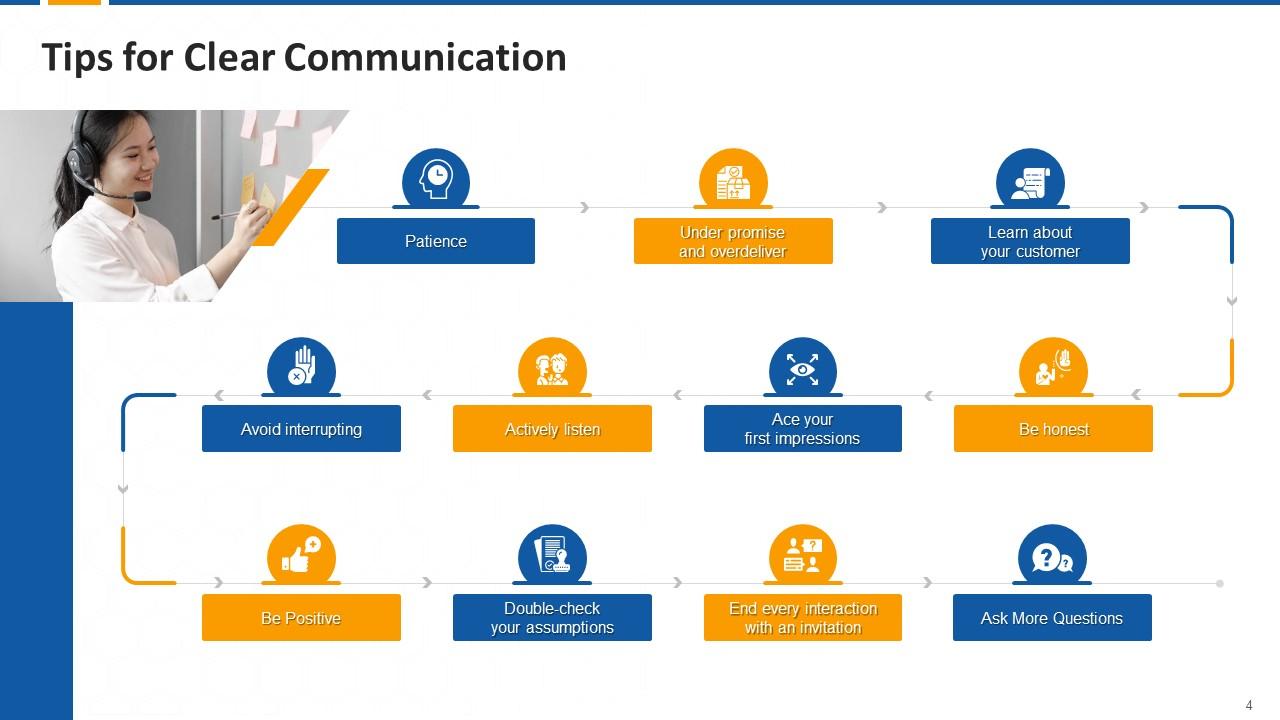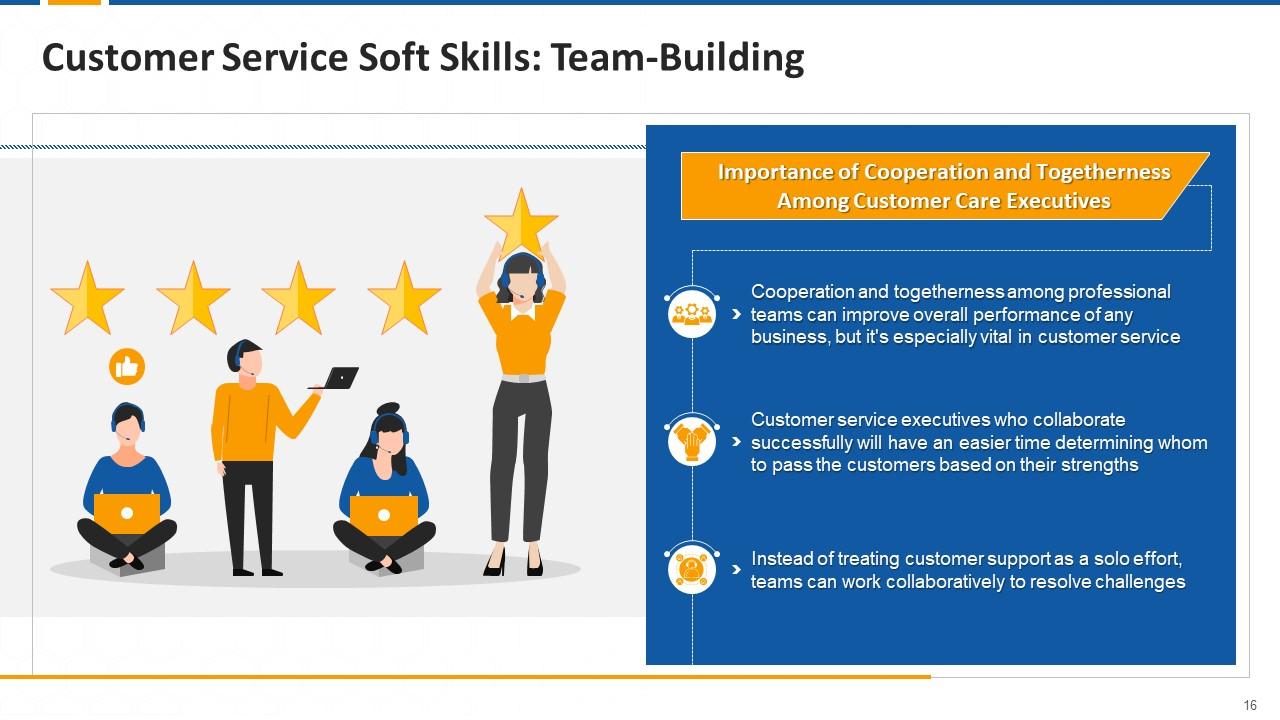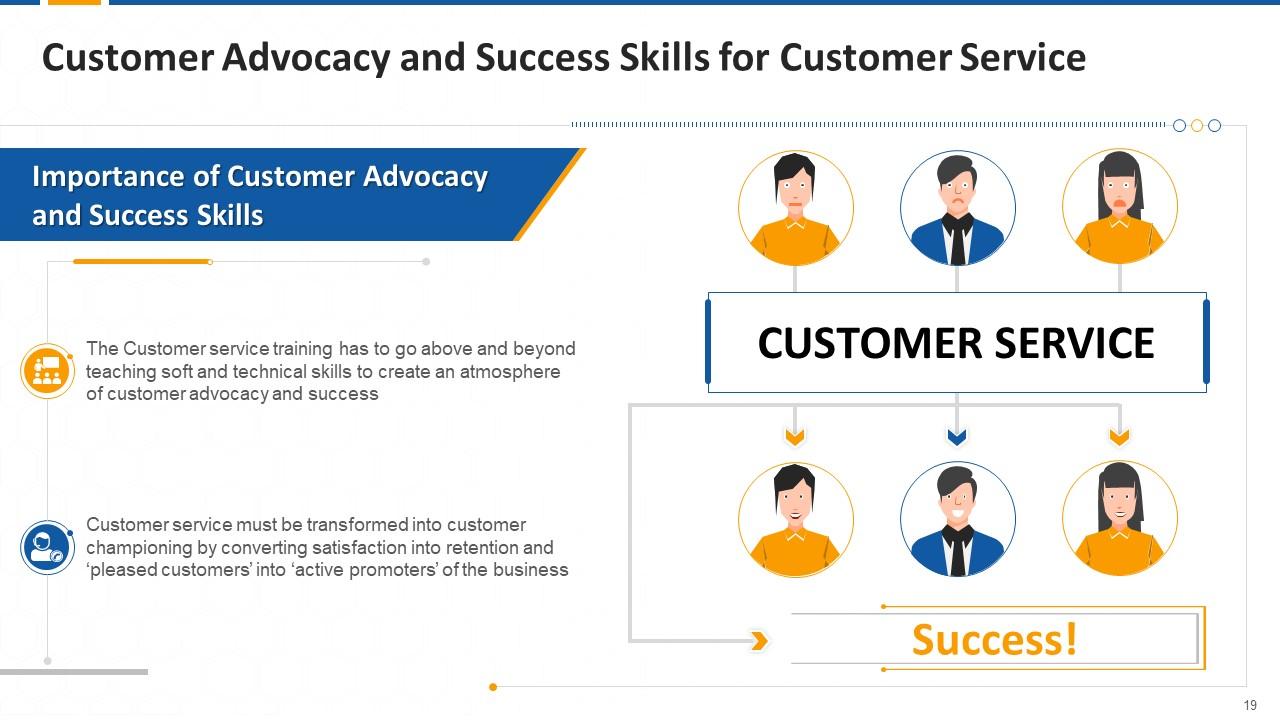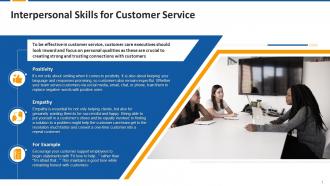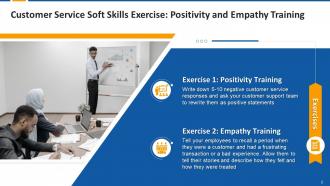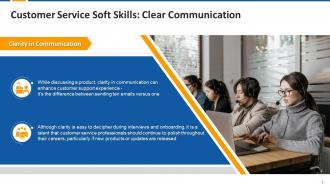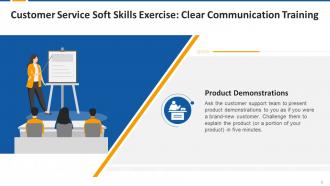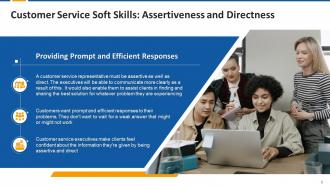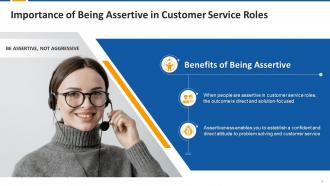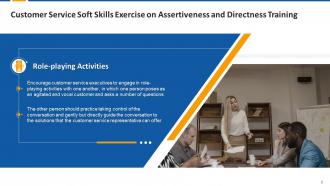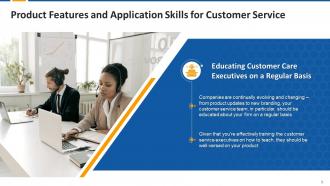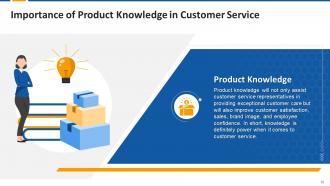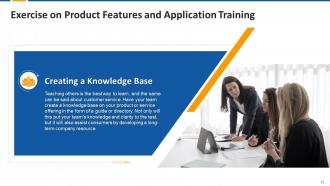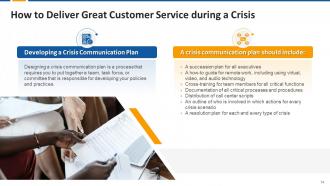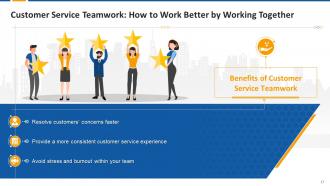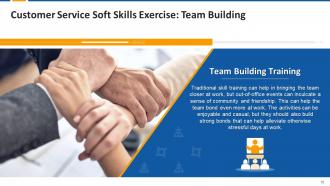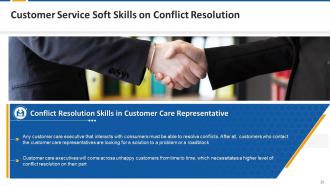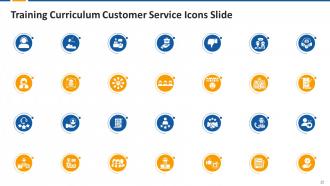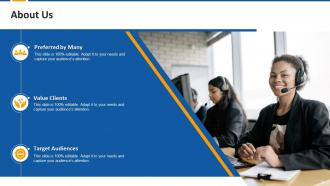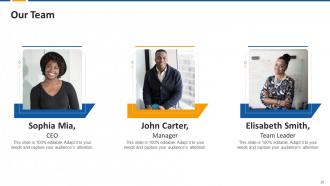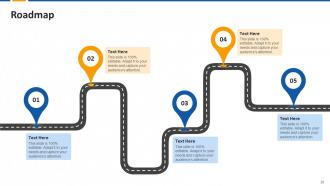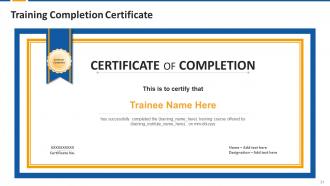Communication Skills For Customer Service Edu Ppt
This set of PPT slides includes essential skills to train the customer service team. It contains significance and tips to improve skills such as communication, assertiveness and directness, product knowledge, and team building to deliver exceptional service.
- Google Slides is a new FREE Presentation software from Google.
- All our content is 100% compatible with Google Slides.
- Just download our designs, and upload them to Google Slides and they will work automatically.
- Amaze your audience with SlideTeam and Google Slides.
-
Want Changes to This PPT Slide? Check out our Presentation Design Services
- WideScreen Aspect ratio is becoming a very popular format. When you download this product, the downloaded ZIP will contain this product in both standard and widescreen format.
-

- Some older products that we have may only be in standard format, but they can easily be converted to widescreen.
- To do this, please open the SlideTeam product in Powerpoint, and go to
- Design ( On the top bar) -> Page Setup -> and select "On-screen Show (16:9)” in the drop down for "Slides Sized for".
- The slide or theme will change to widescreen, and all graphics will adjust automatically. You can similarly convert our content to any other desired screen aspect ratio.
Compatible With Google Slides

Get This In WideScreen
You must be logged in to download this presentation.
PowerPoint presentation slides
Presenting Communication Skills for Customer Service. This slide is well crafted and designed by our PowerPoint specialists. This PPT presentation is thoroughly researched by the experts, and every slide consists of appropriate content. You can add or delete the content as per your need.
People who downloaded this PowerPoint presentation also viewed the following :
Content of this Powerpoint Presentation
This slide covers information regarding why
interpersonal skills are important in building connections with the customers
and shows how positivity and empathy are crucial factors to convert a customer
into repeat customers.
Slide 2
This slide covers an exercise on positivity
and training that can be provided to the customer service executives.
Slide 3
This slide covers the importance of clarity
in communication by a customer service executive while communicating with a customer.
Slide 4
This slide covers information regarding tips
that can be used for clear communication by a customer care executive. The tips
are patience, honesty, effective listening, avoiding interruptions etc.
Instructor’s Notes:
Following are the tips that can be used by a
customer care executive for clear communication-
·
Patience: Have
patience with the customers and try and understand their point of view, even if
they are too aggressive
·
Under
promise and Over deliver: It's easy to offer the world to your
consumers, especially if you think it'll help them relax or make a conversation
go smoothly. Setting reasonable expectations and then exceeding them is always
preferable. Don't give any firm deadlines or commit to anything you're not sure
your team will be able to accomplish
·
Learn
About Your Customer: Before attempting to assist the consumer, the
more information, your staff has, the better it is. Make all of that data
easily accessible to anybody who interacts with customers—the less information
your team needs to get from customers, the better
·
Be Honest:
89% of customers said they're more likely to support
honest brands. If the customer care executive does not have the correct answer
for the customers, tell them you are unsure. Remember to tell them when they
can expect a resolution of the issue
·
Ace Your
First Impressions: First impressions are your finest chance to
make a winning impression. The importance of first impressions, especially
immediate ones, cannot be underestimated. Make sure your staff goes above and
beyond to meet and exceed your clients' expectations
·
Actively
Listen: Active listening is a must for effective
communication. In customer service, active listening involves being completely
attentive to the client's words, comprehending what they mean, and responding
in a way that supports what they're saying
·
Be
Positive: When you use optimistic words, it's simpler to understand and accept bad news.
For example - Which of the two sounds better? "I won't be able to assist
you till next month. We're having supply chain problems, so that's not
available right now." Alternatively, "Next month, that product will
be available. I can place an order for you right now and ensure that it is
dispatched as quickly as possible“
·
Avoid
Interrupting: A customer service representative should not
overwhelm customers with several questions without giving them a chance to
answer
·
Double-check
your assumptions: A customer service executive can ask the
customer to confirm that the assumptions are correct wherever possible. The
following are some phrases that can be used: Can you confirm? & Let me know
if that's right
·
End Every
Interaction With an Invitation- "Is there anything that can be
done", should be the last line of every interaction. It shows to the
customer that you are willing to assist and go an extra mile when necessary
·
Ask More
Questions: Ask about your consumers' feelings. If they
provide you with any insights, make sure you comprehend the context. Always ask
more
Slide 5
This slide covers exercise that can be
provided to the customer service executives on product demonstrations.
Slide 6
This slide covers information regarding how
assertiveness and directness can help customer service executives in
communicating the best solution to the customer’s problems and issues.
Slide 7
This slide covers information regarding the
benefits of being assertive in customer service role.
Instructor’s Notes:
Following are the tips to become more
assertive and to improve the ability to handle customer service scenarios.
·
Don’t
Mistake Assertiveness for Aggression: Aggressive behavior is all about winning, but
assertive behavior is about finding a satisfying solution to a customer's
problem while having a direct and honest approach
·
Think About
Situations: By taking time to understand what a customer
is saying, a customer care representative can prevent appearing as if they have
made a hasty or reactionary decision without thinking. Furthermore, they will
have more processing time, which will allow them to build a confident response
that will satisfy the customer
·
Use ‘I’
Statements: 'I' statements are used in all assertive
statements. They reflect emotional states and interests, whereas 'you'
statements may be interpreted as aggressive and provoke an unwanted response
from a customer. The use of the word "I" is less confrontational
and conveys a direct, authoritative tone
·
Always
Find a Solution: A customer care executive has to be assertive
when they cannot agree to a customer's demands. Instead of saying
"no" to a customer, they can try providing a different solution. A
compelling alternative will make the customer feel like they've had a
productive chat with someone who understands their problem and cares about the
ongoing relationship
·
Tell the
Truth: Assertiveness is based on expressing one's
feelings. A customer service executive can use assertiveness to communicate
effectively with customers by employing short words that clearly express their opinion
Slide 8
This slide depicts an exercise in which
customer service executives can role-play with one another in order to better
resolve their customers' problems.
Slide 9
This slide highlights the importance of
product features training for customer care executives to handle customer queries
regarding product usage effectively.
Slide 10
This slide covers information regarding the
importance of training the customer care executives on the product’s feature so
that they can better assist their customers.
Instructor’s Notes:
How does good product/service knowledge help?
•
Good
customer service: Customer service representatives familiar
with all elements of a company's products/services can address problems more
quickly and effectively
•
Clearer
communications: Product knowledge allows a customer care
executive to accurately and persuasively communicate the benefits and features
of products/services. The more information the agents have, the better they
will be able to communicate
•
Confident
assistance: The customer care executive tone and attitude
become more confident as a result of his/her product understanding
•
Build
trust: When it comes to building trust, all of a
company's customer service representatives must have access to the same,
up-to-date information
For instance, if a consumer receives
different versions of information from various customer service
representatives, customers will be hesitant to associate with the brand. They
will lose faith in your brand. They are more likely to trust brands that
demonstrate confidence in their products.
Slide 11
This slide covers information regarding the
importance of teaching customer service executives about the product so that
they can provide high-level assistance to the customers.
Instructor’s Notes:
The sources from where the customer service
executives can attain product/service knowledge are:
· Product Literature
· Customer Feedback
· Experienced Colleagues
· Production Units
· Training Programmes
· Own User Experience
· Catalogues
Slide 12
This slide shows an exercise how a customer
service staff can establish a knowledge base about a product/service in the
form of a guide or directory to better assist consumers.
Slide 13
This slide covers information regarding the
information regarding crisis management and how it is an essential component of
public relations.
Instructor’s Notes:
Crisis Management Process
· Pre-Crisis: Preventing potential
crises is the first step in crisis management. It includes developing a crisis
management strategy, employing and training a crisis management team, and conducting
mock drills to test your system
· Crisis Management and Response: It
includes the process of dealing with and reacting to various stages of a crisis
· Post-Crisis: Finally,
examine your crisis management strategy with your crisis management team to see
how it performed in a real-life emergency situation
Types of Crisis:
· Personnel crisis: When an
employee or someone else connected to a company engages in unethical or
unlawful behavior, this misconduct can occur in or out of the office and be
related to the individual's professional or personal life
· Organizational crisis: When a
company has wronged its customers by taking measures that negatively
impact its customers. For example, customers who deserve to know the details of
a given topic may be kept in the dark about crucial information
· Technological crisis: When
servers fail, software crashes, or another technological device fails, the
entire network is disrupted. It could cost a company a lot of money, make
customers doubt their trustworthiness, or destroy their reputation
· Natural crisis: Natural
calamities such as hurricanes, floods, and winter storms can damage or destroy
a company's office space. Depending on the location of a company, it may be
more vulnerable to numerous natural calamities that occur throughout the year
The dos and don'ts of crisis management
·
Do have a plan
·
Do restore service ASAP (if possible)
·
Do provide a consistent response
·
Don’t be defensive
·
Don’t make hasty decisions
·
Don’t ignore risk
Slide 14
This slide covers information regarding how
designing a crisis communication plan can help customer service executives to
resolve the crisis.
Instructor’s Notes:
Crisis Communication Tips for Great Customer
Service
· Gather All Necessary Information: First and
foremost, a customer care representative must acquire all necessary facts
regarding the problem to determine the best course of action
· Develop a Crisis Management Team: The next
step is to form a crisis management team that will lead the charge during a
crisis. This group will assist in keeping your company and staff on track and
on task throughout the crisis, as well as prepare the customer care team for
future crisis
· Create a Knowledge Database for the Crisis: It is
critical to provide all relevant information to management, employees, and
customers in order to ensure excellent customer service during a crisis. The
goal should be to equip your company to deal with every situation that arises
· Prepare Crisis Management Customer Service
Responses: The customer care team members will be able
to confidently answer all customer questions in a realistic, clear, helpful,
compassionate, and consistent manner if you have a list of prepared crisis
management responses
· Ensure Management is Always Available: To answer
questions, management should be available at all times via social media, email,
text message, internal systems, or phone. They should be available to deal with
escalated customer care inquiries
· Provide Omni channel Support: By
delivering Omni channel support, a customer care executive can engage with its
consumers anywhere and whenever they choose. It's crucial to connect with
customers on their preferred channel at all times, but it's especially critical
during a crisis. Whether your consumers contact you via email, social media,
live chat, blog, or the phone, you must be available to respond and engage with
them
Slide 15
This slide shows an exercise where customer
service staff can conduct mock calls to resolve a real-life issue with the
product/service.
Slide 16
This slide contains information on how customer service executives can work together as a team to address problems
faced by the customers.
Slide 17
This slide contains information on the
benefits of customer service teamwork. The benefits include a faster resolution
to customer’s concerns and consistent customer service support.
Instructor’s Notes:
Ways to bring your customer service team
closer together
· Speed up and streamline communication between
customer care representatives
· Make your hiring and training process
meaningful, memorable, and personal
· Review your customer personas together
· Appoint a decision-maker
· Make customer information available to
everyone
· Be open about your goals and objectives
Slide 18
This slide shows an exercise where the company
can organize out-of-office events for the customer care executive teams to
bring them together and create strong bonds.
Slide 19
This slide explains how delivering
outstanding customer service may turn customers into active promoters of the
company.
Instructor’s Notes:
Following are the tips to increase customer
advocacy:
· Empower your team with the right tools: A customer
care executive can track customer interactions across many channels with a
helpdesk ticketing system. A help desk can also assign customers to specific
support representatives, track key metrics, and resolve issues quickly and
efficiently
· Train your staff on customer service skills: Well-trained
customer care executives with emotional intelligence and a broad communication
skill set are better at creating customer relationships
· Make your return/cancellation process
painless: An easy return and refund process makes a
business shine in customer's eyes. The chances of doing business with them
again also increase. A company may lose revenue from one canceled order but
will gain a happy customer, even coming back to buy again
· Keep an eye on your metrics: Metrics
can be a pain to track, but they are vital in delivering the best possible
customer service
Some great metrics to track include:
•
Time to
first response
•
Average
resolution time
•
Resolution
rate
•
Customer
satisfaction ratings
Slide 20
This slide explains that a customer care
executive must have a high level of conflict resolution quality to provide
solutions to their customer's problems.
Instructor’s Notes: Following are the conflict resolution tips that can be deployed by
customer care executives in certain situations-
· Set expectations based on previous
experiences
· Clear communication
· Empathy
· Active listening
· Acknowledge customer’s specific needs
· Not to blame anyone
· Say you're sorry
· Stay calm and professional
· Help customers in a way they want to be
helped
· Not to interrupt the person while he/she is
talking
Communication Skills For Customer Service Edu Ppt with all 36 slides:
Use our Communication Skills For Customer Service Edu Ppt to effectively help you save your valuable time. They are readymade to fit into any presentation structure.
-
Content of slide is easy to understand and edit.
-
It is my first time working with them and that too on a friend's recommendation. I would say, I am not expecting such a worldly service at this low price.





